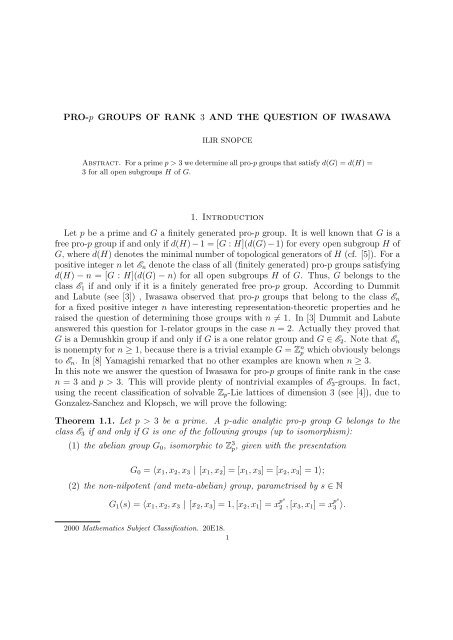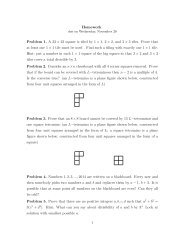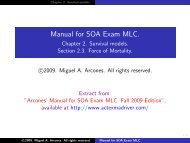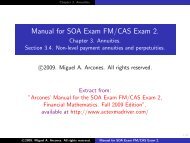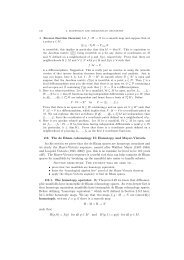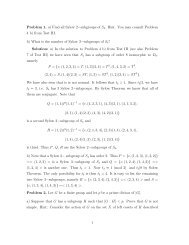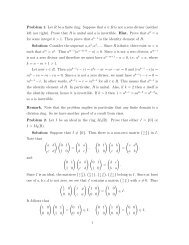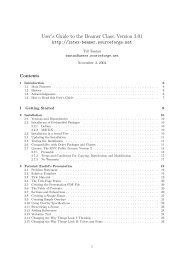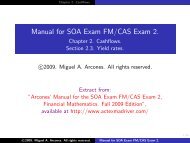PRO-p GROUPS OF RANK 3 AND THE - Department of ...
PRO-p GROUPS OF RANK 3 AND THE - Department of ...
PRO-p GROUPS OF RANK 3 AND THE - Department of ...
You also want an ePaper? Increase the reach of your titles
YUMPU automatically turns print PDFs into web optimized ePapers that Google loves.
<strong>PRO</strong>-p <strong>GROUPS</strong> <strong>OF</strong> <strong>RANK</strong> 3 <strong>AND</strong> <strong>THE</strong> QUESTION <strong>OF</strong> IWASAWA<br />
ILIR SNOPCE<br />
Abstract. For a prime p > 3 we determine all pro-p groups that satisfy d(G) = d(H) =<br />
3 for all open subgroups H <strong>of</strong> G.<br />
1. Introduction<br />
Let p be a prime and G a finitely generated pro-p group. It is well known that G is a<br />
free pro-p group if and only if d(H) − 1 = [G : H](d(G) − 1) for every open subgroup H <strong>of</strong><br />
G, where d(H) denotes the minimal number <strong>of</strong> topological generators <strong>of</strong> H (cf. [5]). For a<br />
positive integer n let En denote the class <strong>of</strong> all (finitely generated) pro-p groups satisfying<br />
d(H) − n = [G : H](d(G) − n) for all open subgroups H <strong>of</strong> G. Thus, G belongs to the<br />
class E1 if and only if it is a finitely generated free pro-p group. According to Dummit<br />
and Labute (see [3]) , Iwasawa observed that pro-p groups that belong to the class En<br />
for a fixed positive integer n have interesting representation-theoretic properties and he<br />
raised the question <strong>of</strong> determining those groups with n = 1. In [3] Dummit and Labute<br />
answered this question for 1-relator groups in the case n = 2. Actually they proved that<br />
G is a Demushkin group if and only if G is a one relator group and G ∈ E2. Note that En<br />
is nonempty for n ≥ 1, because there is a trivial example G = Z n p which obviously belongs<br />
to En. In [8] Yamagishi remarked that no other examples are known when n ≥ 3.<br />
In this note we answer the question <strong>of</strong> Iwasawa for pro-p groups <strong>of</strong> finite rank in the case<br />
n = 3 and p > 3. This will provide plenty <strong>of</strong> nontrivial examples <strong>of</strong> E3-groups. In fact,<br />
using the recent classification <strong>of</strong> solvable Zp-Lie lattices <strong>of</strong> dimension 3 (see [4]), due to<br />
Gonzalez-Sanchez and Klopsch, we will prove the following:<br />
Theorem 1.1. Let p > 3 be a prime. A p-adic analytic pro-p group G belongs to the<br />
class E3 if and only if G is one <strong>of</strong> the following groups (up to isomorphism):<br />
(1) the abelian group G0, isomorphic to Z 3 p, given with the presentation<br />
G0 = 〈x1, x2, x3 | [x1, x2] = [x1, x3] = [x2, x3] = 1〉;<br />
(2) the non-nilpotent (and meta-abelian) group, parametrised by s ∈ N<br />
G1(s) = 〈x1, x2, x3 | [x2, x3] = 1, [x2, x1] = x ps<br />
2 , [x3, x1] = x ps<br />
3 〉.<br />
2000 Mathematics Subject Classification. 20E18.<br />
1
2 Ilir Snopce<br />
2. Pro<strong>of</strong> <strong>of</strong> Theorem 1.1<br />
Our first aim is to show that p-adic analytic pro-p groups which belong to the class E3<br />
are torsion free. For that reason we will need the following:<br />
Lemma 2.1. If G is a uniform pro-p group <strong>of</strong> rank k and p − 1 > k, then G does not<br />
have an automorphism <strong>of</strong> order p.<br />
Pro<strong>of</strong>. Let G be a uniform pro-p group <strong>of</strong> rank k. Then G is <strong>of</strong> dimension k. Corollary<br />
4.18 in [1] indicates that if G is a uniform pro-p group <strong>of</strong> dimension k, then Aut(G) may<br />
be identified with a subgroup <strong>of</strong> GLk(Zp). Hence in order to finish the pro<strong>of</strong> <strong>of</strong> the lemma<br />
it suffices to show that GLk(Qp) has no elements <strong>of</strong> order p if p − 1 > k, and this is a<br />
consequence <strong>of</strong> the fact that the p-th cyclotomic polynomial is irreducible over Qp. Indeed,<br />
if A is a matrix <strong>of</strong> order p acting on a vector space V and v ∈ V , then the annihilator <strong>of</strong><br />
v, i.e. the polynomial f <strong>of</strong> smallest degree such that f(A)v = 0, divides the polynomial<br />
x p − 1. It follows that f is either x − 1 or the p-th cyclotomic polynomial or x p − 1. In<br />
the first case Av = v and in the other cases the subspace spanned by v, Av, A 2 v, ... has<br />
dimension at least p − 1. Thus if A is not the identity then V has dimension at least<br />
p − 1. <br />
We know that a pro-p group G is p-adic analytic if and only if it is <strong>of</strong> finite rank, i.e. if<br />
and only if there exists a positive constant c such that d(H) ≤ c for every open subgroup<br />
H <strong>of</strong> G. Now let G ∈ En for some positive integer n be a p-adic analytic pro-p group.<br />
Since d(H) − n = [G : H](d(G) − n) for all open subgroups H <strong>of</strong> G, and d(H) ≤ c we<br />
must have d(G) = n = d(H). So a p-adic analytic pro-p group G belongs to the class En<br />
if and only if d(G) = n = d(H) for all open subgroups H <strong>of</strong> G. Now we can prove the<br />
following:<br />
Proposition 2.2. Let k be a positive integer and p a prime such that p − 1 > k. If a<br />
p-adic analytic pro-p group G belongs to the class Ek, then G is torsion free.<br />
Pro<strong>of</strong>. Let G be a p-adic analytic pro-p group that belongs to Ek for p − 1 > k, and let<br />
us assume that G has a torsion element. Since G is p-adic analytic it has a characteristic<br />
uniform pro-p subgroup <strong>of</strong> finite index, call it U. Let x ∈ G be an element <strong>of</strong> order p<br />
and H = 〈U, x〉 ≤ G. Then [H : U] = p and U H. Hence H is a semidirect product<br />
<strong>of</strong> U and 〈x〉. By the previous lemma, Aut(U) does not have an element <strong>of</strong> order p, so it<br />
follows that H = U × 〈x〉. But in this case we have d(H) = k + 1 since d(U) = k, which<br />
contradicts the fact that G belongs to the class Ek. Hence G does not contain any torsion<br />
element. <br />
Corollary 2.3. Let p > 3 be a prime. Every p-adic analytic pro-p group that belongs to<br />
the class E3 is torsion free.<br />
Now let us recall how we define the Qp-Lie algebra <strong>of</strong> a p-adic analytic group (see [1] for<br />
more details.). Let G be a p-adic analytic group. Then it has a characteristic subgroup<br />
which is uniform. For every open uniform subgroup H ≤ G, Qp[H] can be made into a
Pro-p groups <strong>of</strong> rank 3 and the question <strong>of</strong> Iwasawa 3<br />
normed Qp-algebra, A, and log(H), considered as a subset <strong>of</strong> the completion  <strong>of</strong> A, has<br />
the structure <strong>of</strong> a Lie algebra over Zp. There is a different construction <strong>of</strong> an intrinsic Lie<br />
algebra over Zp for uniform groups. The uniform group U and its Lie algebra over Zp,<br />
call it LU, are identified as sets and the Lie operations are defined by<br />
g + h = lim (g<br />
n→∞ pn<br />
h pn<br />
) p−n<br />
, [g, h] = lim (g<br />
n→∞ pn<br />
, h pn<br />
) p−2n<br />
= lim (g<br />
n→∞ −pn<br />
h −pn<br />
g pn<br />
h pn<br />
) p−2n<br />
.<br />
This construction also works for saturable groups. It turns out that the Zp-Lie algebra<br />
log(H) is isomorphic to the Zp-Lie algebra LH. In [4] Gonzalez-Sanchez and Klopsch<br />
showed that every torsion-free p-adic analytic pro-p group <strong>of</strong> dimension less than p is saturable,<br />
and there is a one-to-one correspondence between the p-adic analytic pro-p groups<br />
<strong>of</strong> dimension less than p and residually-nilpotent Zp-Lie lattices <strong>of</strong> dimension less than<br />
p. Under this correspondence the closed subgroups correspond to the Zp-Lie sublattices<br />
and the normal subgroups correspond to the Lie ideals. Moreover, the solvable groups<br />
correspond to the solvable Lie lattices.<br />
If H1 and H2 are both open uniform subgroups <strong>of</strong> G, then H = H1 ∩H2 has finite index<br />
in both H1 and H2, so LH has finite index in both LHi , for i = 1, 2. Hence<br />
Therefore we can unambiguously define<br />
Qp ⊗Zp LH1 = Qp ⊗Zp LH = Qp ⊗Zp LH2.<br />
L(G) = Qp ⊗Zp LH,<br />
where H is any uniform open subgroup <strong>of</strong> G. Thus L(G) is a Lie algebra over Qp,<br />
<strong>of</strong> dimension equal to dim(H) = dim(G). From the above discussion we have that<br />
L(G) = Qp ⊗Zp LH ∼ = Qp ⊗Zp log(H). Also let us mention that for a uniform (saturable)<br />
pro-p group U the group structure can be reconstructed from the Lie algebra<br />
stucture <strong>of</strong> LU by the Baker-Campbell-Hausdorf series.<br />
Before we prove the theorem, we need to recall some notions (see [6]). Let G be a<br />
group and S(G) the set <strong>of</strong> all finite index subgroups <strong>of</strong> G. If we define H1 ≥ H2 when<br />
H1 ⊆ H2, then S(G) becomes a directed system. If f is a real-valued function with<br />
domain S(G) then {f(H)}H∈S(G) is a net, so we can talk about lim sup and lim inf.<br />
Denote L f(G) = lim inf{f(H)}H∈S(G) and ¯ Lf(G) = lim sup{f(H)}H∈S(G). Now let G be<br />
a finitely generated pro-p group and f(H) = d(H) =the minimal number <strong>of</strong> topological<br />
generators <strong>of</strong> H. In this case S(G) is the set <strong>of</strong> open subgroups. Since a finite index<br />
subgroup <strong>of</strong> a finitely generated group is also finitely generated we have d : S(G) → N.<br />
In ([6], Proposition 4.1) Lubotzky and Mann showed that if G is an analytic pro-p<br />
group then L d(G) = d(L(G)), where L(G) is the Lie algebra <strong>of</strong> G and d(L(G)) denotes<br />
its minimal number <strong>of</strong> generators. As a consequence <strong>of</strong> this result they proved that if<br />
L d(G) = ¯ Ld(G) < ∞ for a finitely generated pro-p group G, then G is meta-abelian by
4 Ilir Snopce<br />
finite.<br />
We can apply these results in our case. We observed that if a p-adic analytic pro-p<br />
group G belongs to the class E3 then d(G) = 3 = d(H) for all open subgroups H <strong>of</strong> G.<br />
Therefore for these groups we have L d(G) = ¯ Ld(G) = 3. Hence d(L(G)) = 3 and G is a<br />
meta-abelian by finite group. In particular G is solvable.<br />
Pro<strong>of</strong> <strong>of</strong> theorem 1.1. Let p > 3 be a prime and let G be a p-adic analytic pro-p group<br />
that belongs to the class E3. By Proposition 1.2 we have that G is torsion-free and by the<br />
above discussion G is saturable and solvable. Therefore we can associate a 3-dimensional<br />
Zp-Lie algebra LG to G. The Lie algebra LG is solvable and residually-nilpotent. Now let<br />
us list the solvable 3-dimensional and residually-nilpotent Lie algebras for p > 3. All <strong>of</strong><br />
them are additively isomorphic to Z 3 p, so they are <strong>of</strong> the form Zpe1 ⊕ Zpe2 ⊕ Zpe3. Up to<br />
isomorphism the following Lie algebras appear (cf. Proposition 7.3, Theorem 7.4 in [4]):<br />
(1) The abelian algebra,<br />
L0(∞) = 〈e1, e2, e3 | [e1, e2] = [e1, e3] = [e2, e3] = 0〉.<br />
(2) The two-step nilpotent Lie algebras, parametrized by s ∈ N0,<br />
L0(s) = 〈e1, e2, e3 | [e1, e2] = p s e3, [e1, e3] = [e2, e3] = 0〉.<br />
(3) A family <strong>of</strong> non-nilpotent Lie algebras, parametrized by s ∈ N,<br />
L1(s) = 〈e1, e2, e3 | [e2, e3] = 0, [e2, e1] = p s e2, [e3, e1] = p s e3〉.<br />
(4) A family <strong>of</strong> non-nilpotent Lie algebras, parametrized by s, r ∈ N and d ∈ Zp,<br />
L2(s, r, d) = 〈e1, e2, e3 | [e2, e3] = 0, [e2, e1] = p s e2 + p s+r de3, [e3, e1] = p s+r e2 + p s e3〉.<br />
(5) A family <strong>of</strong> non-nilpotent Lie algebras, parametrized by s, r ∈ N0 and d ∈ Zp such<br />
that (a) s ≥ 1 or (b) r ≥ 1 and d ∈ pZp,<br />
L3(s, r, d) = 〈e1, e2, e3 | [e2, e3] = 0, [e2, e1] = p s de3, [e3, e1] = p s e2 + p s+r e3〉.<br />
(6) A family <strong>of</strong> non-nilpotent Lie-algebras, parametrised by s, r ∈ N0 with s + r ≥ 1,<br />
L4(s, r) = 〈e1, e2, e3 | [e2, e3] = 0, [e2, e1] = p s+r e3, [e3, e1] = p s e2〉.<br />
(7) A family <strong>of</strong> non-nilpotent Lie algebras, parametrised by s, r ∈ N0 with s + r ≥ 1,<br />
L5(s, r) = 〈e1, e2, e3 | [e2, e3] = 0, [e2, e1] = p s+r ρe3, [e3, e1] = p s e2〉,<br />
where ρ ∈ Z ∗ p is a non-square modulo p.<br />
Assume LG is one <strong>of</strong> the Lie algebras which belongs to (2), (4), (5), (6) or (7). Then<br />
easily we can see that d(L(G)) ≤ 2 in this case, which contradicts the result <strong>of</strong> Lubotzky<br />
and Mann that d(L(G)) = 3. So LG belongs to (1) or (3). The case (1) obviously works,<br />
because then G ∼ = Z 3 p. So just the case (3) remains to be checked. If LG is one <strong>of</strong> the<br />
Lie algebras in the case (3), then G has a presentation as in (2) in the statement <strong>of</strong> the<br />
theorem. To finish the pro<strong>of</strong> <strong>of</strong> the theorem it suffices to show that in this case LG is
Pro-p groups <strong>of</strong> rank 3 and the question <strong>of</strong> Iwasawa 5<br />
three generated and that every subalgebra <strong>of</strong> LG <strong>of</strong> finite index is three generated.<br />
Let K be an additive subgroup <strong>of</strong> LG <strong>of</strong> finite index. Since Zp is a Euclidean domain,<br />
there is a ‘triangular’ basis for K:<br />
k1 = αe1 + βe2 + γe3, k2 = µe2 + νe3, k3 = ηe3.<br />
The subgroup K is a subalgebra <strong>of</strong> LG if and only if it is closed under the Lie bracket.<br />
We have<br />
[k2, k3] = 0, [k3, k1] = [ηe3, αe1 + βe2 + γe3] = αηp s e3 = αp s k3,<br />
[k2, k1] = [µe2 + νe3, αe1 + βe2 + γe3] = αµp s e2 + ανp s e3 = αp s k2.<br />
Hence every additive subgroup <strong>of</strong> LG is a subalgebra. Moreover, they are Lie algebras <strong>of</strong><br />
the same type as LG. From the above calculations <strong>of</strong> the Lie bracket we also get that<br />
every subalgebra <strong>of</strong> LG can not be generated with two elements, hence they are three<br />
generated Zp-Lie algebras.<br />
<br />
3. Some remarks<br />
We finish the paper by making some general remarks about pro-p groups that belong<br />
to the class En.<br />
Proposition 3.1. Let G be a finitely presented pro-p group and assume that one <strong>of</strong> the<br />
following holds:<br />
(1) there do not exist a closed subgroup K <strong>of</strong> G and a finitely generated (as a discrete<br />
group) subgroup X <strong>of</strong> G normalizing K such that XK/K is an infinite torsion<br />
group;<br />
(2) G does not contain a free non-abelian pro-p group <strong>of</strong> rank ≥ 2.<br />
If G ∈ En for some positive integer n, then d(G) = d(H) = n for all open subgroups H <strong>of</strong><br />
G.<br />
Pro<strong>of</strong>. Let G be a finitely presented pro-p group that satisfies condition (1) in the proposition.<br />
On the one hand, by Wilson’s result ([7], Corollary A) we have that there is a<br />
constant k > 0 such that d(H) ≤ k|G : H| 1<br />
2 for each open subgroup H <strong>of</strong> G. On the other<br />
hand, since G ∈ En we have that d(H) − n = [G : H](d(G) − n). Hence<br />
n + [G : H](d(G) − n) = d(H) ≤ k|G : H| 1<br />
2<br />
for all open subgroups H <strong>of</strong> G, which implies that d(G) − n = 0, and consequently<br />
d(H) = n.<br />
Now let G be a finitely presented pro-p group that satisfies condition (2) in the proposi-<br />
tion. By the result <strong>of</strong> Zelmanov ([2], 7, Theorem A), similarly as in the pro<strong>of</strong> <strong>of</strong> Corollary<br />
A in [7], we get that there is a constant k > 0 such that d(H) ≤ k|G : H| 1<br />
2 for each open
6 Ilir Snopce<br />
subgroup H <strong>of</strong> G. Thus, as above we have that d(G) = d(H) = n for all open subgroups<br />
H <strong>of</strong> G. <br />
Since finitely generated discrete solvable torsion groups are finite, we get the following:<br />
Corollary 3.2. Let G be a finitely presented solvable pro-p group. If G ∈ En for some<br />
positive integer n, then d(G) = d(H) = n for all open subgroups H <strong>of</strong> G. In particular,<br />
G is p-adic analytic, so if n = 3 and p > 3, then G is one <strong>of</strong> the groups in Theorem 1.1.<br />
Remark Note that the property that there exists a constant k > 0 such that d(H) ≤<br />
k|G : H| 1<br />
2 for all open subgroups H <strong>of</strong> G is clearly inherited by homomorphic images.<br />
Therefore the above corollary holds not only for finitely presented solvable pro-p groups,<br />
but also for homomorphic images <strong>of</strong> such groups.<br />
It seems a very interesting question to investigate E3-groups which are not p-adic analytic.<br />
Acknowledgement I am extremely grateful to my advisor Pr<strong>of</strong>. Marcin Mazur for<br />
his guidance during the preparation <strong>of</strong> this paper.<br />
References<br />
[1] J. D. Dixon, M. P. F. du Sautoy, A. Mann, and D. Segal. Analytic pro-p groups, volume 61 <strong>of</strong><br />
Cambridge Studies in Advanced Mathematics. Cambridge University Press, Cambridge, second edition,<br />
1999.<br />
[2] Marcus du Sautoy, Dan Segal, and Aner Shalev, editors. New horizons in pro-p groups, volume 184<br />
<strong>of</strong> Progress in Mathematics. Birkhäuser Boston Inc., Boston, MA, 2000.<br />
[3] D. Dummit and J. Labute. On a new characterization <strong>of</strong> Demuskin groups. Invent. Math., 73(3):413–<br />
418, 1983.<br />
[4] B. Klopsch and J. Gonzalez-Sanchez. Analytic pro-p groups <strong>of</strong> small dimensions. to appear in J.<br />
Group Theory, available as arXiv:0806.2968v1 at http://arxiv.org/.<br />
[5] Alexander Lubotzky. Combinatorial group theory for pro-p-groups. J. Pure Appl. Algebra, 25(3):311–<br />
325, 1982.<br />
[6] Alexander Lubotzky and Avinoam Mann. Powerful p-groups. II. p-adic analytic groups. J. Algebra,<br />
105(2):506–515, 1987.<br />
[7] John S. Wilson. Finite presentations <strong>of</strong> pro-p groups and discrete groups. Invent. Math., 105(1):177–<br />
183, 1991.<br />
[8] Masakazu Yamagishi. An analogue <strong>of</strong> the Nielsen-Schreier formula for pro-p-groups. Arch. Math.<br />
(Basel), 88(4):304–315, 2007.<br />
<strong>Department</strong> <strong>of</strong> Mathematical Sciences, Binghamton University, Binghamton, New York<br />
13902-6000<br />
E-mail address: snopce@math.binghamton.edu


